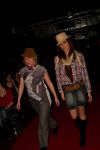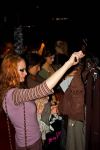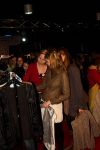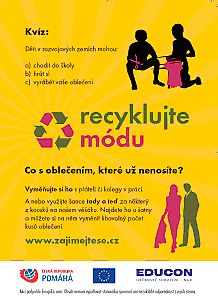Clothes Swapping for MDGs 7 and 8
or
How to make development educational events 'sexy' to Young Modern Performers
Centre
1st step – Get the venue ready
We were around the place from early afternoon with our volunteers. We split them into groups with various tasks: accepting the clothes brought in, bartending, and being stage helpers. We designated a special place for the clothes racks, where the clothes were being collected. It was in a different room from where the program was taking place. That turned out to be a very good idea, as we wanted to use the pieces brought for the fashion show and also people were very anxious about seeing the clothes.
We started arranging the stage and the club according our scenography scheme. We decorated the walls with an exhibition that was explaining the life cycle of clothes.
2nd step – Collect the clothes while you have the stand-up comedy performance
Before 7 pm, the first attendees started showing up. By that time, the DJ was already playing. The attendees were all given vouchers for their clothes and offered a welcome drink as well as fair trade and organic food (chocolate, biscuits etc.). There were also other two NGOs present with information material specifically on fair trade and fair clothes campaigns. In the meanwhile, before all the clothes from the late coming guests were gathered, everyone could enjoy themselves with the DJ and stand-up comedy show.
3rd step – Fashion show
In the meanwhile, we were preparing the fashion show. We had two students of design that were putting various outfits together from the clothes that people brought to the event. The fashion show was a great success. People could actually see that you can create great looks from the pieces people brought in. For the fashion show, we used our friends and some of the volunteers as models.
4th step – Presentation on life cycle of clothes
Then we wanted to use the attention of the people to introduce them more to the issue of clothes production in the developing countries. We had a short presentation done by a former member of the student team that was working on a project for the British Council. The project was aimed at the life cycle of our clothing.
5th step – Let the swapping begin
At this moment, most of the attendees (especially women) were already very anxious for the swap to start. When we brought the racks in, they went crazy and started checking and trying the clothes on. In twenty minutes, there were only a few pieces left.
6th step – Make sure the swap goes according to the rules
We had the volunteers checking if everyone got as many pieces as they were allowed. However, it was not really necessary.
7th step – Prepare the two week follow-up swap
With an event that is organized in an appealing way, you can reach many YMPs. If you want to extend the range of people that you reach, there are many options for follow-up to an event. Again, it is important to think about where to situate that follow-up action. Places that the guests of the event actually visit often are desireable.
After the clothes swapping event that we presented here, the second part of the swap continued for the following 14 days. We placed a clothes rack with some clothes for a swap in the cloakroom of Rock Café. On the poster next to the stand and on flyers on the tables, we communicated the possibility of swapping clothes that people have with them for the clothes on the clothes stand and motivating them to do so also in their daily life (with their colleagues, friends, etc.), and connecting the whole action with the Millennium goal.
Translation of the flyer on the tables:
Quiz:
Children in developing countries may: a) walk to school b) play c) make your clothes
Recycle the fashion
Clothes can be recycled
What can you do with clothes which you aren't still wearing?
Exchange with your friends or collegues. Or you can take a chance here and now – exchange it for something on our clothes-rack. You can find it near the cloakroom and you can exchange an arbitrary number of your clothes.
The action is supported by the European Union. The content doesn't necessarily express the point of view of our patrons and they can't be responsible for it.






